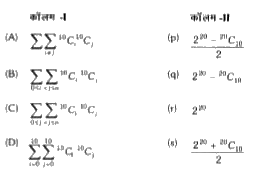माना हम निश्चित समाकलन को निम्नलिखित सूत्र से परिभाषित करते है ∫baf(x)dx=b−a2[f(a)+f(b)]
c∈(a,b) के लिए और अधिक उपर्युक्त परिणाम के लिए,
F(c)=c−a2[f(a)+f(c)]+b−c2[f(b)+f(c)] जब c=a+b2,∫baf(x)d(x)=b−a4[f(a)+f(b)+2f(c)]
यदि f''(x)<0∀x∈(a,b) तथा c एक बिन्दु इस प्रकार है कि a<c<b तथा (c,f,(c)) वक्र पर बिन्दु है जिसके लिए F(c) उच्चिष्ठ है, तब f'(c) बराबर है
f(b)−f(a)b−a
2f(b)−f(a)b−a
2f(b)−f(a)2b−a
0
The correct Answer is:A
Step by step video, text & image solution for माना हम निश्चित समाकलन को निम्नलिखित सूत्र से परिभाषित करते है int_(a)^(b)f(x)dx = (b-a)/2 [f(a) +f(b)] c in (a,b) के लिए और अधिक उपर्युक्त परिणाम के लिए, F (c) = (c-a)/2 [f(a) +f(c) ] +(b-c)/2[f(b)+f(c)] जब c=(a+b)/2, int _(a)^(b) f(x)d(x) = (b-a) /(4) [f(a) + f(b) + 2f(c)] यदि f''(x)lt 0 AAx in (a,b) तथा c एक बिन्दु इस प्रकार है कि a lt c lt b तथा (c,f,(c)) वक्र पर बिन्दु है जिसके लिए F(c) उच्चिष्ठ है, तब f'(c) बराबर है by Maths experts to help you in doubts & scoring excellent marks in Class 12 exams.
Updated on:21/07/2023Topper's Solved these Questions
- निश्चित समाकलन एवं वक्रों से घिरा क्षेत्रफल Book:ERRORLESS HINDIChapter:निश्चित समाकलन एवं वक्रों से घिरा क्षेत्रफल Exercise:JEE ADVANCED (Integer type questions)
Explore 17 Videos
- निश्चित समाकलन एवं वक्रों से घिरा क्षेत्रफल Book:ERRORLESS HINDIChapter:निश्चित समाकलन एवं वक्रों से घिरा क्षेत्रफल Exercise:JEE ADVANCED (Matrix Match type questions)
Explore 9 Videos
- निश्चित समाकलन एवं वक्रों से घिरा क्षेत्रफल Book:ERRORLESS HINDIChapter:निश्चित समाकलन एवं वक्रों से घिरा क्षेत्रफल Exercise:JEE ADVANCED (Reasoning type questions)
Explore 8 Videos
- द्विपद प्रमेय तथा गणितीय आगमन Book:ERRORLESS HINDIChapter:द्विपद प्रमेय तथा गणितीय आगमन Exercise:JEE Advanced (Matrix Math type questions)
Explore 5 Videos
- प्रायिकताBook:ERRORLESS HINDIChapter:प्रायिकताExercise:EXERCISE
Explore 99 Videos
Similar Questions
दिया है कि किसी वास्तविक संख्या x के लिए [x], अधिकतम पूर्णांक को दर्शाता है यदि अन्तराल [−10,10] पर वास्तविक मानो वाला फलन f निम्न प्रकार से परिभाषित है f(x)={x−[x],यदि [x] विषम है,1+[x]−x, यदि [x] सम है तो π210∫10−10f(x)cosπxdx का मान है
View Solutionकॉलम I में दिए गए समाकलनों का कॉलम II में दिए गए मानों से सुमेल करे
कॉलम Iकॉलम II(A)∫1−1dx1+x2(p)12log(23)(B)∫10dx√1−x2(q)2log(23)(C)∫32dx1−x2(r)π3(D)∫21dxx√x2−1(s)π2
View Solutionकथन-1 : समाकलन ∫π/3π/6dx1+√tanx का मान π/6 है
कथन-2 : ∫baf(x)dx=∫baf(a+b−x)dx
View Solutionनिम्नलिखित कॉलम I को कॉलम II से मिलाये

View SolutionA, B, C तीन परस्पर स्वतंत्र घटनायें हैं। S1 तथा S2 दो कथनों को देखने पर
S1 : A तथा B∪C स्वतन्त्र हैं
S2 : A तथा B∩C स्वतन्त्र हैं तब
View SolutionSuppose we define the definite integral using the following formula ∫baf(x)dx=b−c2(f(a)+f(b)) , for more accurate result for c∈(a,b)F(c)=b−c2(f(a)−f(c))+b−c2(f(b)−f(c)). When c=a+b2,∫baf(x)dx=b−a4(f(a)+f(b)+f(2f(c)) then ∫π20sinxdx
View SolutionIf f(x)<0, x∈(a,b) then at the point C(c, f(c)) on y=f(x) for whichF(c) is a maximum, f′(c) is given by a.f′(c)=f(b)−f(a)b−1 b. f′(c)=f(b)−f(a)a−b c.f′(c)=2(f(b)−f(a))b−a d. f′(c)=0
View SolutionLet the definite integral be defined by the formula ∫baf(x)dx=b−a2(f(a)+f(b)). For more accurate result, for cε(a,b), we can use ∫baf(x)dx=∫caf(x)dx+∫bcf(x)dx=F(c) so that for c=a+b2 we get ∫baf(x)dx=b−a4(f(a)+f(b)+2f(c)).
If f''(x)<0∀xε(a,b) and c is a point such that a<c<b, and (c,f(c)) is the point lying on the curve for which F(c) is maximum then f'(c) is equal to
View SolutionFor every function f (x) which is twice differentiable , these will be good approximation of
∫baf(x)dx=(b−a2){f(a)+f(b)}, for more acutare results for c∈(a,b),F(c)=c−a2[f(a)−f(c)]+b−c2[f(b)−f(c)]
When c=a+b2
∫baf(x)dx=b−a4{f(a)+f(b)+2f(c)}dx
If limt→a∫taf(x)dx−(t−a)2{f(t)+f(a)}(t−a)3=0, then degree of polynomial function f (x) atmost is
View SolutionFor every function f (x) which is twice differentiable , these will be good approximation of
∫baf(x)dx=(b−a2){f(a)+f(b)}, for more acutare results for c∈(a,b),F(c)=c−a2[f(a)−f(c)]+b−c2[f(b)−f(c)]
When c=a+b2
∫baf(x)dx=b−a4{f(a)+f(b)+2f(c)}dx
If f''(x)<0,∀x∈(a,b),and(c,f(c)) is point of maxima , where c∈(a,b), then f ' ( c) is
View SolutionFor every function f (x) which is twice differentiable , these will be good approximation of
∫baf(x)dx=(b−a2){f(a)+f(b)}, for more acutare results for c∈(a,b),F(c)=c−a2[f(a)−f(c)]+b−c2[f(b)−f(c)]
When c=a+b2
∫baf(x)dx=b−a4{f(a)+f(b)+2f(c)}dx
Good approximation of ∫π/20sinxdx,is
View SolutionIf f(a,b)=f(b)−f(a)b−a and
f(a,b,c)=f(b,c)−f(a,b)c−a prove that f(a,b,c)=∣∣ ∣ ∣∣f(a)f(b)f(c)111abc∣∣ ∣ ∣∣÷∣∣ ∣ ∣∣111abca2b2c2∣∣ ∣ ∣∣.
View SolutionLet y=f(x) be a twice differentiable, non- negative function defined on [a.b]. The area ∫baf(x)dx,b> a bounded by y=f(x), the x-axis and the ordinates at x=aandx=b can be approximated as
∫baf(x)dx≈(b−a)2{f(a)+f(b)}.
Since ∫baf(x)dx=∫caf(x)dx+∫bcf(x)dx,xˆI(a,b),a better approximation to ∫baf(x)dx can be written as ∫baf(x)dx@(c−a)2{f(a)+f(c)}(b−c)2
{f(c)+f(b)}∘F(c),
If c=b−a2, then this gives:
∫baf(x)dx@b−a4{f(a)+2f(a)+2f(c)+f(b)},.......(1)
If f''(x)<0,x∈(a,b), then at the point
C(c,f(c))ony=f(x) for which F(c ) is a maximum,
f'(c) is given by
View Solutionनिम्न अनुच्छेद को पढ़कर प्रश्नो के उत्तर दीजिए
एक द्विआवकलनीय फलन f(x) के लिए, ∫baf(x)≅(b−a2){f(a)+f(b)} एक अच्छा सन्निकटन (approximation) है। यदि हम c=a+b2 ले, तब उपरोक्त को पुनः प्रयोग करने पर,
∫baf(x)dx=∫caf(x)dx+∫bcf(x)dx≅b−a4{f(a)+f(b)+2f(c)}
यदि f''(x)<0,∀x∈(a,b) और [c,f(c)} एक उच्चिष्ठ बिन्दु है, जहाँ c∈(a,b) तो f'(c) है।
View SolutionLet the definite integral be defined by the formula ∫baf(x)dx=b−a2(f(a)+f(b)). For more accurate result, for cε(a,b), we can use ∫baf(x)dx=∫caf(x)dx+∫bcf(x)dx=F(c) so that for c=a+b2 we get ∫baf(x)dx=b−a4(f(a)+f(b)+2f(c)).
If f''(x)<0∀xε(a,b) and c is a point such that a<c<b, and (c,f(c)) is the point lying on the curve for which F(c) is maximum then f'(c) is equal to
View Solution

